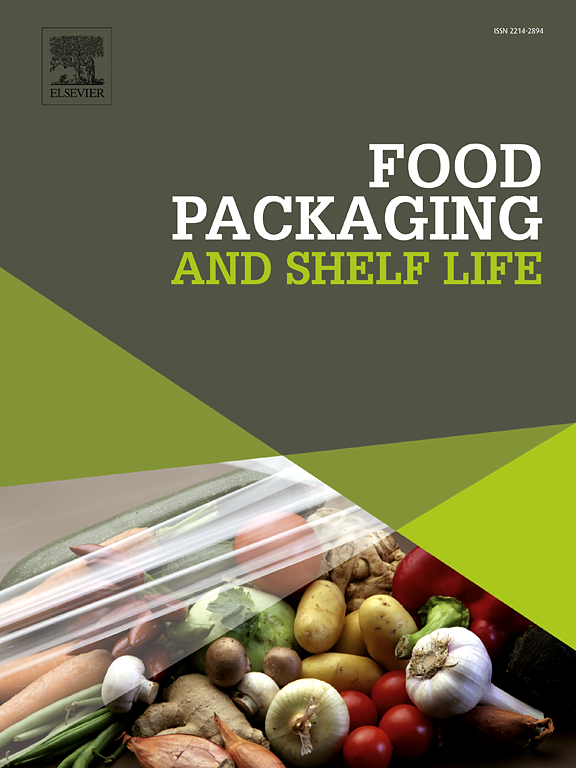不同改性方法对未充分利用荞麦淀粉薄膜性能的优化
IF 10.6
1区 农林科学
Q1 FOOD SCIENCE & TECHNOLOGY
引用次数: 0
摘要
研究了荞麦淀粉薄膜的成膜性能。在此基础上,研究了柠檬酸(CA)交联和壳聚糖纳米颗粒(CNP)包合、壳聚糖和壳聚糖纳米颗粒膜的热固化、壳聚糖和壳聚糖纳米颗粒成膜溶液的超声处理等不同改性策略对BW淀粉膜性能的影响。结果表明,CA交联改性膜和CNP改性膜的水蒸气透过率(WVTR)和水蒸气透过率(WVP)最低。经超声处理的CA和cnp处理的薄膜的抗拉强度比未经改性的薄膜高147 %,断裂伸长率低70 %。薄膜改性也导致了抗吸湿性的提高。CA固化膜和cnp处理膜的最大热封强度(HSS)为0.08 N/mm。扫描电镜显示,CA和cnp修饰的膜表面光滑,验证了它们与薄膜制备的相容性。傅里叶红外(FTIR)分析发现,在1709 cm−1处出现了一个新的峰值,表明酯基的CO拉伸,证明了官能团之间的交联反应。这项工作促进了简单的方法来改善未充分利用的BW淀粉基薄膜的拉伸和阻隔性能,用于各种包装应用。本文章由计算机程序翻译,如有差异,请以英文原文为准。
Optimization of the properties of underutilized buckwheat starch films through different modification approaches
The present research explored the film-forming ability and properties of buckwheat (BW) starch films. Further, we studied the effect of different modification strategies, such as citric acid (CA) cross-linking and the inclusion of chitosan nanoparticles (CNP), heat curing of CA and CNP films, and ultrasonication of CA and CNP filmogenic solutions, on the properties of BW starch films. The results indicated that films modified by CA cross-linking and CNP had the lowest water vapor transmission rate (WVTR) and water vapor permeability (WVP). The CA and CNP-treated film with ultrasonic treatment exhibited 147 % higher tensile strength and 70 % lower elongation at break than its unmodified counterpart. Film modifications also resulted in an improved resistance to moisture sorption. The maximum heat seal strength (HSS) (0.08 N/mm) was observed in cured CA and CNP-treated films. A scanning electron microscope revealed that the surface of the CA and CNP-modified films was smooth, validating their compatibility with filmmaking. Fourier Transform Infrared (FTIR) analysis revealed a new peak at 1709 cm−1, exhibiting C![]() O stretching of the ester group, demonstrating the crosslink reactions between the functional groups. This work promotes simple methods to improve underutilized BW starch-based films' tensile and barrier properties for various packaging applications.
O stretching of the ester group, demonstrating the crosslink reactions between the functional groups. This work promotes simple methods to improve underutilized BW starch-based films' tensile and barrier properties for various packaging applications.
求助全文
通过发布文献求助,成功后即可免费获取论文全文。
去求助
来源期刊

Food Packaging and Shelf Life
Agricultural and Biological Sciences-Food Science
CiteScore
14.00
自引率
8.80%
发文量
214
审稿时长
70 days
期刊介绍:
Food packaging is crucial for preserving food integrity throughout the distribution chain. It safeguards against contamination by physical, chemical, and biological agents, ensuring the safety and quality of processed foods. The evolution of novel food packaging, including modified atmosphere and active packaging, has extended shelf life, enhancing convenience for consumers. Shelf life, the duration a perishable item remains suitable for sale, use, or consumption, is intricately linked with food packaging, emphasizing its role in maintaining product quality and safety.
 求助内容:
求助内容: 应助结果提醒方式:
应助结果提醒方式:


